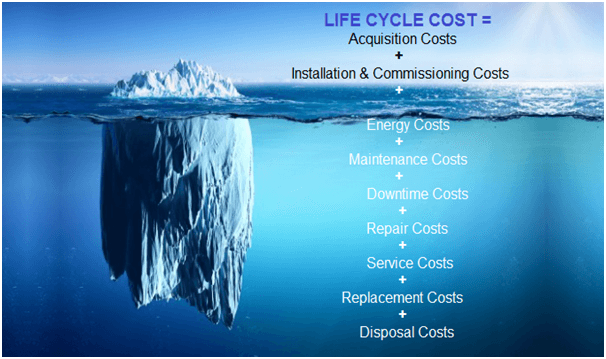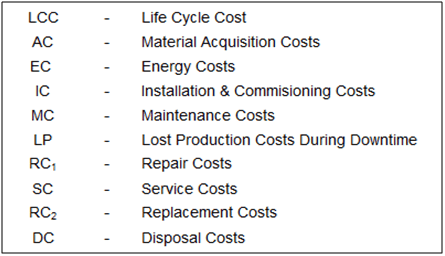Life Cycle Costing Acquisition is a process that acquires item or equipment from another organisation in legal and ethical manner that based on life cycle costing (LCC) i.e. whole cycle of item or equipment of its desired service life. This aspect is worth consideration as it is highly overlooked by stakeholders that may greatly impact on bottom-line.

Table of Contents
Computing Life Cycle Cost
By using life cycle costing technique, procurement can identify and quantify all costs, the entire cycle is associated with a project or installation over a given period. This includes material acquisition costs, installation and commissioning costs, operating and maintenance costs, repair costs, service costs, lost production costs during downtime, replacement material or equipment costs and disposal of material or equipment costs. While air compressors equipped with IE3 efficiency class motor may have a higher purchase price as compared to normal class motor, they tend to have lower cycle costs due to less frequency of maintenance activity is required and even no maintenance is required for the first few years that helps to increase cost saving.
In light of less maintenance is required and therefore contributing more saving on service costs as well. In short, less maintenance of equipment, will reduce wear and tear on parts. With continuous production output, relatively increase productivity and will generate higher revenue.




Factors for Life Cycle Cost Analysis
- Material Acquisition Costs
It is usually just a small part of total cost of life cycle. Even though the cost is cheaper for normal class motor, the overall price is much more expensive compared to the efficiency class motor.
- Installation and Commissioning Costs
It will vary depending on the type and model of item or equipment being selected and it may include electrical configuration and foundation requirements, among other costs including commissioning costs
- Maintenance Costs
It can be vary enormously. To keep the item or equipment in tip top condition, it is required to follow the required maintenance schedules. Therefore, with different recommendation services interval by manufacturers and component lifetimes that can have a huge impact on cost incurred over its lifetime eventually.
- Service Costs
Basically, certain equipment need to have its oil changed e.g. air compressor, filter cleaned and filter replaced when is required. The service interval of air compressor is very much depending of utilization level or level of activity carried out of its lifetime.
- Repair Costs
Labour and transportation charges can vary greatly if the purchase item or equipment to be repaired by overseas expertise due to flight charges, accommodation and traveling time.
- Energy Costs
Latest technology model of equipment or component e.g. compressor can contribute to energy efficiency which could potentially save more than an average of 15% as compared to normal version of the model. For example, the low rotation speed of the air end and 1:1 direct coupling between the good performance of compressor and the electric motor can ensure energy saving in long run.
- Lost Production during Downtime
This is one of the major challenges to the manufacturing line when downtime happens as the impact can be significant and outrageous losses will be incurred. If the downtime situation is not managed properly, it may lead to further complexity and result to poor financial performance and affects an organisation’s reputation and sustainability. In addition, lack of engineering skills will prolong the downtime period and cause the productivity to plummet.
- Replacement Costs
When equipment is out of order, every process flow from your production to your bottom line is disrupted. Operations Team has to figure out quick and effective solutions in order to reduce downtime incurred. In light of larger investment for replacement equipment, decisive decisions has to be made whether to repair or replace the malfunction equipment to not affect the production schedule as to fulfil customer’s requirement.
- Disposal Costs
Last but not least, most organisations only consider this factor when the charges increases gradually due to stringent rules and regulations that are exercised by relevant authorities obliged by organisations and such measures are usually very costly.

Challenges for Life Cycle Cost Analysis
The life cycle cost analysis tool helps organisations to measure their long term sustainability as well as improve their bottom line. It can be an effective cost-saving tool for parties that are involved. On top of that, it can reveal the most sensible option for procurement to make optimal decision to purchase the right item or equipment to meet company’s goal.
The full content is only visible to SIPMM members
Already a member? Please Login to continue reading.
References
Angelene Chin Pei Sze, DPSM. (2020). “Crucial Factors for Sustainable Procurement”. Retrieved from SIPMM: https://publication.sipmm.edu.sg/crucial-factors-for-sustainable-procurement, accessed 15/09/2020.
Assetworks. (2020). “Common Challenges with Life-Cycle Cost Analysis”. Retrieved from https://www.assetworks.com/fleet-life-cycle-cost-analysis-overcome, accessed on 12/09/2020.
Julie Kwek Choo Lie, ADLSM. (2020). “Key Focus Areas for Supply Chain Integration”. Retrieved from SIPMM: https://publication.sipmm.edu.sg/key-focus-areas-supply-chain-integration, accessed 15/09/2020.
Ken Hensley. (2019). “Icebergs & Spiritual Growth”. Retrieved from https://medium.com/@kenhensley/icebergs-and-spiritual-growth-1a92a490483e, accessed on 20/09/2020.
Lai Sok Yen, DPSM. (2019). “Costs Reduction Strategy through Supplier-Managed Inventory”. Retrieved from SIPMM: https://publication.sipmm.edu.sg/cost-reduction-strategy-through-supplier-managed-inventory, accessed on 20/09/2020.
Nurazyyati Jaffar, ADPSM. (2018). “Key Strategies to Build an Effective Supplier Relationship Management”. Retrieved from SIPMM: https://publication.sipmm.edu.sg/key-strategies-build-effective-supplier-relationship-management, accessed on 16/09/2020.
SSINA. (2020). “Life Cycle Costing”. Retrieved from https://www.ssina.com/value-propositions/life-cycle-costing, accessed on 12/09/2020.

